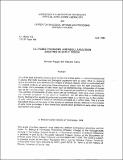Ill-Posed Problems and Regularization Analysis in Early Vision
| dc.contributor.author | Tomaso, Poggio | en_US |
| dc.contributor.author | Torre, Vincent | en_US |
| dc.date.accessioned | 2004-10-04T14:55:02Z | |
| dc.date.available | 2004-10-04T14:55:02Z | |
| dc.date.issued | 1984-04-01 | en_US |
| dc.identifier.other | AIM-773 | en_US |
| dc.identifier.uri | http://hdl.handle.net/1721.1/6402 | |
| dc.description.abstract | One of the best definitions of early vision is that it is inverse optics --- a set of computational problems that both machines and biological organisms have to solve. While in classical optics the problem is to determine the images of physical objects, vision is confronted with the inverse problem of recovering three-dimensional shape from the light distribution in the image. Most processes of early vision such as stereomatching, computation of motion and the "structure from" processes can be regarded as solutions to inverse problems. This common characteristic of early vision can be formalized: most early vision problems are "ill-posed problems" in the sense of Hadamard. We will show that a mathematical theory developed for regularizing ill-posed problems leads in a natural way to the solution of the early vision problems in terms of variational principles of a certain class. This is a new theoretical framework for some of the variational solutions already obtained in the analysis of early vision processes. It also shows how several other problems in early vision can be approached and solved. | en_US |
| dc.format.extent | 1550885 bytes | |
| dc.format.extent | 1110788 bytes | |
| dc.format.mimetype | application/postscript | |
| dc.format.mimetype | application/pdf | |
| dc.language.iso | en_US | |
| dc.relation.ispartofseries | AIM-773 | en_US |
| dc.title | Ill-Posed Problems and Regularization Analysis in Early Vision | en_US |
